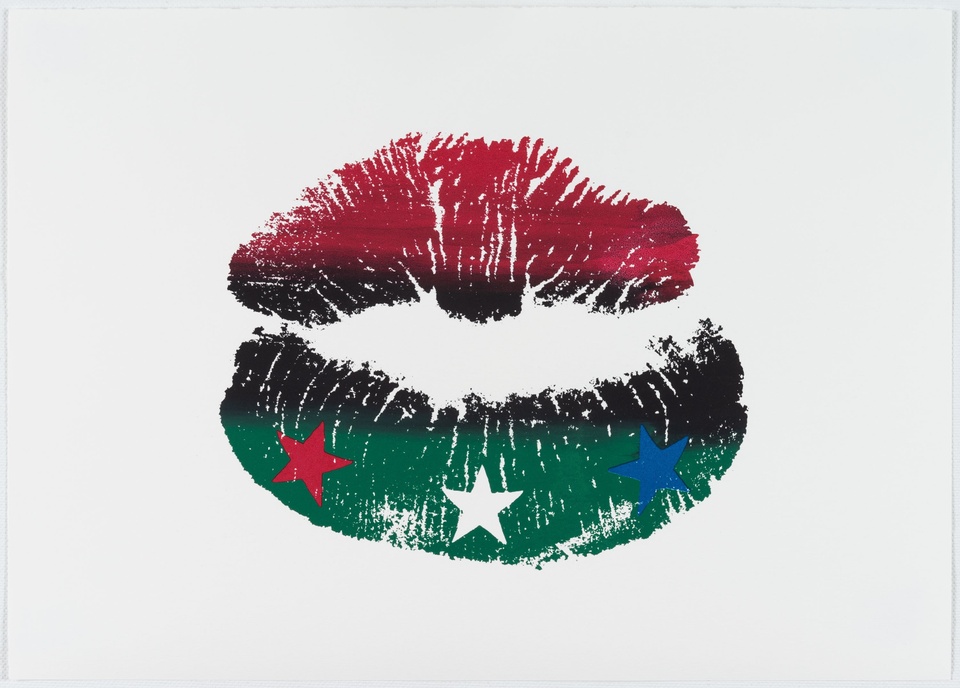L bARBER
b and e
bARBER was named the recipient of the 2020 Island Press Emerging Artist Research Fellowship. Due to the COVID-19 pandemic, his residency was rescheduled for June 2021.
For his project at Island Press, bARBER created a complex and playful double portrait, b and e. This is a 4 plate collagraph and relief print with a la poupée inking and chine collé on Hannemuhle Copperplate Bright White paper.
PROOF essay by Lucia Olubunmi Momoh, the Constance E. Clayton Curatorial Fellow at the Philadelphia Museum of Art
When presented in art and the media, our bodies—Black bodies, queer bodies—carry social, political, and cultural connotations that can obstruct our vision, preventing us from truly seeing that person. Believing that “the body represents the least of who we are,” interdisciplinary artist bARBER chooses to eliminate figural representation from his work. He instead breaks the body down to his own hieroglyph-like system of shapes, lines, and colors that rely on proximity to recall a personality and narrative without relying on the charged corporeal form of the people who inspire his art. His work invokes Caribbean theorist Édouard Glissant’s demand for the right to opacity, which presupposes identity to be irreducibly singular and obscure, even to oneself. For bARBER creates abstracted portraits of Black people that work to both disentangle us from designated cultural categories and celebrate the divergent and intersectional elements of their identity, utilizing abstraction as a liberatory practice.
While form may be purposefully cryptic in appearance, colors are utilized to evoke emotion. Thus, in bARBER’s work feeling is knowledge. Bright greens denote new growth, while deep indigos and blues signify melancholic introspection. Colors can also function as political tools. One of bARBER’s most transparent works made during his residency at Island Press is an untitled depiction of large, luscious lips printed in red, black, and green—his Black American State Flag—is inspired by David Hammons’ African American Flag (1990). The lips are overlayed with stars printed in red, white and blue—colors and shapes meant to recall Betsy Ross’s U.S. flag. This untitled print infuses socially significant colors with recognizable forms to create this blatant statement on nationhood, race, and sexuality. Meanwhile, b and e (2021) utilizes color to evoke emotions from which we can gather insight.
The print, b and e, can be read as a self-portrait though it is also a representation of a pivotal moment in a private relationship between the artist, “b”, and persons unknown, “e”. Here, bARBER has broken the body down into lines and shapes and added substance through texture and color. Limited to six colors—green, pink, Kermit, Chocolate, gray, Grapes— bARBER chose each deliberately. A bright, warm green swims around a central figure made up of a rectangular and cruciform body with a large, round, multicolored head. The use of brown seems to connote skin tone, and thus identity, while negative space throughout the “body” perhaps signals an emptiness left in the wake of this event. Composed of two shades of yellow and crude, decisive lines, a sun shines down on the central figure potentially causing the brilliant greens and tiny bursts of eggplant and pink drawn in floral forms, which together seem to signify change, rebirth, and renewal. What is taking place is purposefully opaque, but how we’re supposed to feel is mapped onto the print through a composition and color scheme that signify transformation and growth coupled with loss.
B and e manages to focus our attention on the narrative at play instead of the gender, ethnicity, or sexuality of the people involved. Whether self-portrait or double-portrait, the work subverts traditional epistemologies of portraiture by utilizing abstraction as a tool for abolition by disregarding and reimagining the markers that define and ultimately confine us. Instead, bARBER has forced the viewer to contend with emotions that change and affect all our lives.

bARBER, Untitled (Black American Flag Lips), Screenprint, 11 x 15 ½ inches, Edition of 10
HELPER PRINT
Untitled (Black American Flag Lips) is the Helper Print created by bARBER during his residency to give to the assistants and interns that worked on his project. His flag is inspired by David Hammons’ African American Flag (1990) and was made from a direct impression of bARBER’s own lips.
This Helper Print is not available for purchase through Island Press.







